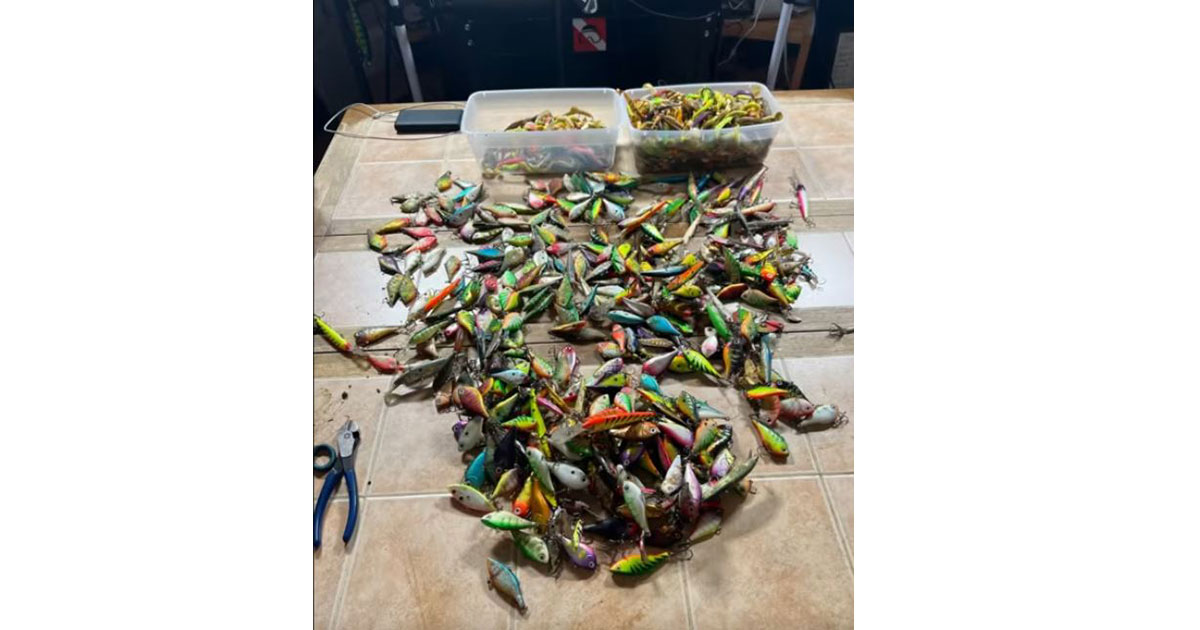- Details
Mercury Report

When Ed Bieber was growing up on a family farm in little Lena, Wisconsin, he learned to work hard — and play hard, too. The family owned a few boats over the years, and Bieber spent countless happy hours fishing, waterskiing, and kneeboarding.
“As I kid, I would take a mask and go underwater, holding my breath,” Bieber remembers.
His love of underwater exploring, combined with his interest in fishing, led to him becoming known as “Ed the Diver” on social media. He now has nearly 200,000 followers across multiple platforms, and millions of people have viewed his content.
A New Social Media Star
As a young adult, Bieber didn’t never considered that he might find his calling in the water. He worked factory jobs, got married, and after his divorce, raised his son and daughter, who are now 19 and 17 years old.
A hands-on dad, Bieber frequently took his kids fishing at Stephenson Island in the Menominee River, which runs between Marinette, Wisconsin, and Menominee, Michigan. Part of fishing is losing lures, and in addition to losing their own, they often came across those lost by others.
“I kept saying, get those, they’re expensive!” he recalls with a laugh.
And so, in 2017, Bieber’s Underwater Recovery was born. It started with a cheap diving mask, swim trunks, and an old pair of gym shoes.
- Details
By Louie Stout
Don’t forget that both Indiana and Michigan fishing licenses need renewed April 1.
Licenses are available at some tackle retailers or online.
For Indiana, visit: https://www.in.gov/dnr/fish-and-wildlife/licenses-and-permits/.
For Michigan, visit: https://www.michigan.gov/dnr/things-to-do/fishing/license-info.
Here are the fees for both states:
Michigan:
Resident all species $26
Non-resident all species $76
Daily $10
Indiana:
Resident $23 plus trout and salmon $11
Non-resident all species $60
Daily $15
Resident Senior $3 (includes trout and salmon)
- Details
MDNR Report
As ice and snow cover melt on Michiana lakes this spring, you may see dead fish or other aquatic animals. Given the return to a more “normal” Michigan winter this year — with more cold days and near-average snowfall across the state — you may notice more dead fish than you have in the past few years.
While such sights can be startling, the DNR reminds everyone that it is normal for winter conditions to cause some mortality of fish and other creatures such as turtles, frogs, toads and crayfish.
“Winterkill is the most common type of fish kill," said Aaron Switzer, Michigan DNR Fish Production Program manager. "It can be particularly common in shallow lakes, ponds, streams and canals during seasonal changes. It’s a natural phenomenon, and these kills are localized. They typically do not affect the overall health of fish populations or fishing quality.”
Shallow lakes with a large amount of aquatic vegetation and soft bottoms are more prone to winterkill, particularly when a deep snowpack reduces sunlight for the plants. Canals in urban areas also are quite susceptible, due to the large amounts of nutrient runoff and pollution from roads, lawns and septic systems that flow into these areas, especially after large storm events.
- Details
St. Croix Report
 Joe Duncannon
Joe Duncannon
Duncannon, Pennsylvania fishing guide and St. Croix Rod Ambassador, Joe Raymond, must be living right.
Almost a month to the day after catching a 7.1-pound personal-best smallmouth bass that many believe to be the largest ever recorded on the Susquehanna River, Raymond caught another fish that has the internet buzzing. This one, however, was over twice as long and seven times heavier. No, it wasn’t a smallmouth bass.
“I was taking some time off and bass fishing up at the St. Lawrence River,” says Raymond, who always carries muskie gear on the deck of his Rockproof River Rocket when plying the waters of the storied fishery.
“I’m not a muskie expert… just an enthusiast,” Raymond emphasizes. “I was scouting some new spots for bass the night before the full moon. Some of my areas have been getting a lot more pressure, so I was just exploring on my day off.”
Raymond was marking bass and working some scattered rocks along a grass line at about 5:00 PM when his Legend X spinning rod doubled over.
“I hooked a three-pound bass and was fighting it back to the boat when I saw a big muskie charge up with gills flared right underneath it,” Raymond recalls. He describes the fish as a bona fide supertanker. “This fish was as fired up to eat as they come, but I couldn’t throw back at it because I wasn’t rigged up,” he says. Raymond unhooked the bass and hurriedly grabbed his muskie rod.
After tying on a substantial chunk of white rubber, Raymond started fan casting with his Legend Elite Muskie LEM86HF. “I couldn’t locate the fish on my electronics, so I was just casting and ripping the bait along that grass line,” he says. After about 20 minutes of rip… pause… rip, Raymond says his lure hard-stopped and he set the hooks into “all the weight in the world.”
The St. Lawrence River has some of the biggest muskies to be found anywhere and claims a historical world record – a 69-15 fish caught by Arthur Lawton in 1957. “Historical” because although the catch is still recognized as the NY state record by the New York Department of Environmental Conservation, it was disallowed as a world record by both the Freshwater Fishing Hall of Fame and the International Game Fish Association amidst much controversy – like so many other old muskie records. That said, there’s no arguing that the St. Lawrence has produced numerous documented muskies over 50 pounds. Over the past few years, Raymond himself had already caught three fish there 55 inches or greater.
And he suspected the fish he was tied into might be his biggest yet.
“I was pretty sure the fish with my lure in its mouth was the same giant that had followed my bass to the boat,” Raymond says. “It was fighting like crazy… just dug and dug and dug, but I’ve been fooled before; I’ve caught 44-inchers that I swore were going to be a whole lot bigger. I had my drag totally locked down and was giving this fish everything my equipment and I had to get it into the net as quickly as possible.” When he got the fish near the boat, his suspicions were confirmed. “I’m sure it was the same fish,” he says. “Long, deep, and incredibly girthy all the way down through its tail. The fish was still punching and surging, but I saw it was well hooked, so I backed off the drag a half turn. I knew I had her.”
 55
55
Raymond slid the giant into his net. He taped the fish at 55” long and 27” around.
“I was shaking and just wishing someone else was there to share the experience,” says Raymond, who spotted some people on a nearby beach and idled over with the fish in the net to ask for their help with a couple of photos. “They were interested in what I’d caught and were happy to help. They were so nice,” he says. While Raymond didn’t weigh the fish, he speculates it was somewhere just north of 50 pounds, making it the heaviest of his life — a statement backed up by common muskie length/girth weight calculators.
Takeaways
Raymond says he was fortunate to locate a trophy fish on a body of water known for giant muskies at the right time. “Anyone who puts time in chasing muskies knows what a grind it usually is,” he says. “Timing definitely matters. You can go days without catching or even moving one, then you hit a feeding window and the switch flips and you might see and catch several. That’s why I don’t guide for muskies; I really don’t want that kind of pressure… plus, I don’t want to ruin muskie fishing for myself.”
Raymond says if you are fortunate enough to catch one of these big, old St. Lawrence muskies – or a big muskie anywhere – you’ve really got to be extra careful with them. “Other than taking a couple of photos and measuring it, this fish was kept in the water the whole time. That’s important. And when you do take them out, despite their size and how resilient they may seem, they’re actually more fragile than about any other trophy fish. Gravity alone can injure a fish like this, so how you lift and handle them matters.”





